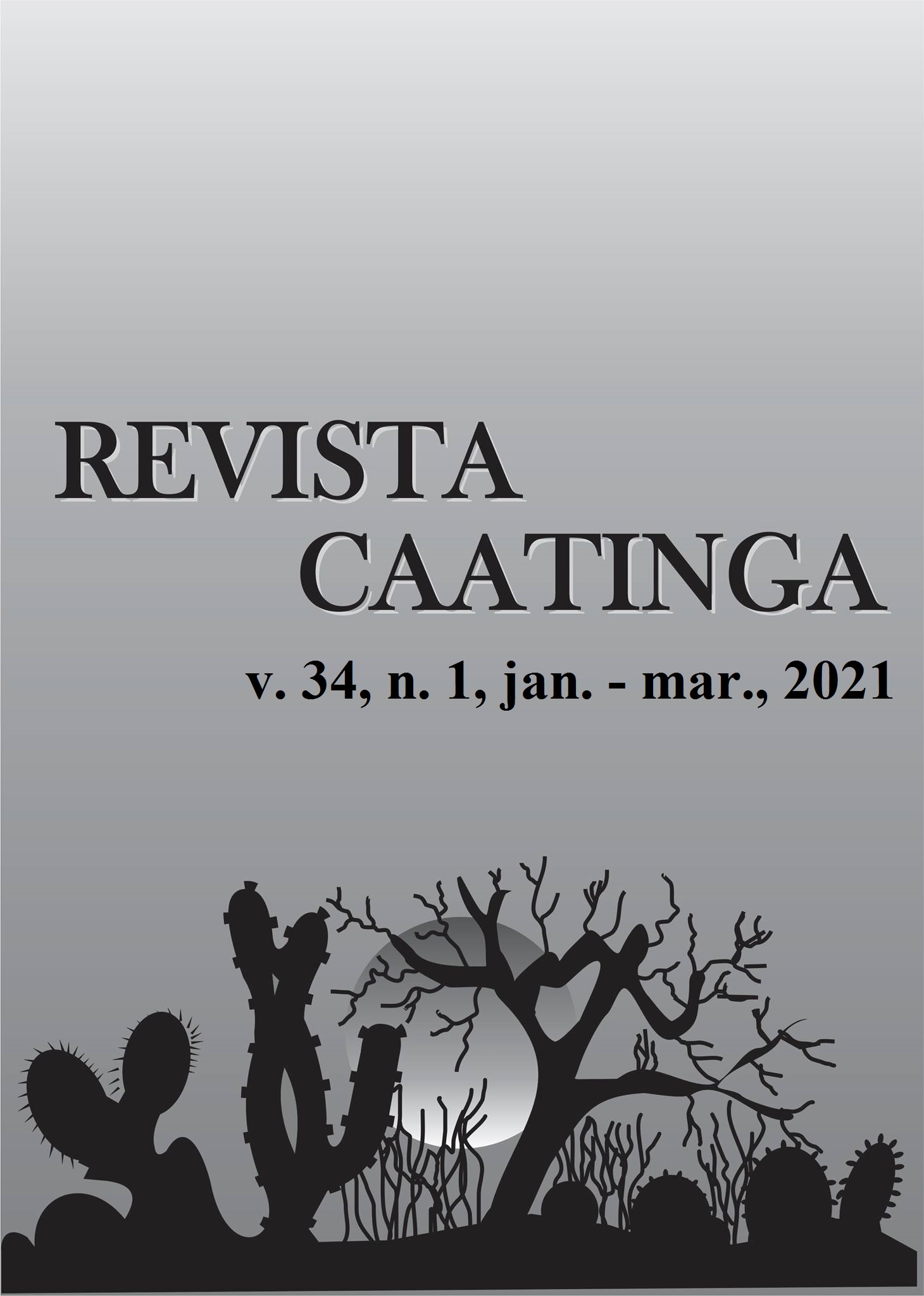COMPOSIÇÃO FITOQUÍMICA E ANTIOXIDANTE EM ACESSOS DO BANCO ATIVO DE GERMOPLASMA DE MANGABA
DOI:
https://doi.org/10.1590/1983-21252021v34n123rcPalavras-chave:
Frutas brasileiras. Compostos fenólicos. Rutina. Atividade antioxidante.Resumo
A mangabeira (Hancornia speciosa Gomes) é uma espécie frutífera nativa do Brasil, pertencente à família Apocynaceae. Seu cultivo é predominantemente extrativista e suas propriedades antioxidantes têm sido recentemente relatadas. O objetivo do presente trabalho foi avaliar os compostos bioativos e atividade antioxidante em frutos de acessos oriundos do Banco Ativo de Germoplasma da Embrapa Tabuleiros Costeiros (BI, CA, LG, PR, PT e TC). Os extratos foram analisados em cromatografia líquida de alta eficiência (HPLC) e identificou-se o ácido clorogênico (93,71 - 131,66 mg.100g-1); ácido ferúlico (0,85 - 2,27 mg.100g-1) e rutina (238,59 - 442,94 mg.100g-1). Os acessos CA e PR apresentaram os maiores valores de fenóis totais (1179,39 e 1167,05 mg EAG.100g-1, respectivamente). Os acessos CA e TC apresentaram a maior concentração do composto majoritário rutina (436,78 e 442,94 mg.100g-1, respectivamente). Os valores da atividade antioxidante variaram entre 125,95 e 158,67 g.g-1 DPPH. A análise de componentes principais agrupou os acessos em quatro grupos, em consequência da variabilidade genética previamente verificada em estudos anteriores. Os resultados serão úteis para direcionar ações de seleção e futuro programa de melhoramento genético da espécie.
Downloads
Referências
ALMEIDA, M. M. B. et al. Bioactive compounds and antioxidant activity of fresh exotic fruits from northeastern Brazil. Food Research International, 44: 2155-2159, 2011.
ALVES, R. D. B. et al. Manual de curadores de germoplasma-vegetal: caracterização química de metabólitos secundários em germoplasma vegetal. Brasília: Embrapa Recursos Genéticos e Biotecnologia, 2010. 12 p.
BASTOS, K. X. et al. Identification of phenolic compounds from Hancornia speciosa (Apocynaceae) leaves by uhplc orbitrap-hrms. Molecules, 22: 143, 2017.
BECHO, J. R. M.; MACHADO, H.; OLIVEIRA, M. G. Rutina–estrutura, metabolismo e potencial farmacológico. Revista Interdisciplinar de Estudos Experimentais, 1: 21-25, 2009.
BRAND-WILLIAMS, W.; CUVELIER, M. E.; BERSET, C. L. W. T. Use of a free radical method to evaluate antioxidant activity. LWT-Food science and Technology, 28: 25-30, 1995.
COSTA, T. S. et al. Genetic diversity of accessions of the mangaba germplasm bank in Sergipe, Brazil. Pesquisa Agropecuária Brasileira, 46: 499-508, 2011.
GOMES, E. B. et al. A rapid method for determination of some phenolic acids in brazilian tropical fruits of mangaba (Hancornia speciosa Gomes) and Umbu (Spondias tuberosa Arruda Camara) by UPLC. Journal of Analytical Sciences, Methods and Instrumentation, 3: 1-10, 2013.
KRAUJALYTĖ, V. et al. Antioxidant properties and polyphenolic compositions of fruits from different European cranberrybush (Viburnum opulus L.) genotypes. Food Chemistry, 141: 3695–3702, 2013.
LIMA, J. P. et al. First evaluation of the antimutagenic effect of mangaba fruit in vivo and its phenolic profile identification. Food Research International, 75: 216–224, 2015.
MANCUSO, C.; SANTANGELO, R. Ferulic acid: Pharmacological and toxicological aspects. Food and Chemical Toxicology, 65: 185-195, 2014.
MORAES, T. M. et al. Hancornia speciosa: indications of gastroprotective, healing and anti-Helicobacter pylori actions. Journal of Ethnopharmacology, 120: 161-168, 2008.
PÉREZ-JIMÉNEZ, J.; SAURA-CALIXTO, F. Effect of solvent and certain food constituents on different antioxidant capacity assays. Food Research International, 39: 791-800, 2006.
PUUPPONEN-PIMIA, R. et al. Antimicrobial properties of phenolic compounds from berries. Journal of Applied Microbiology, 90: 494–507, 2001.
RUFINO, M. S. M. et al. Metodologia científica: determinação da atividade antioxidante total em 46 frutas pela captura do radical livre DPPH. Fortaleza, CE: Embrapa Agroindústria Tropical, 2007. 4 p. (Comunicado Técnico, 127).
RUFINO, M. S. M. et al. Bioactive compounds and antioxidant capacities of 18 non-traditional tropical fruits from Brazil. Food Chemistry, 121: 996–1002, 2010.
SANTOS, P. S. et al. Genetic diversity and the quality of mangabeira tree fruits (Hancornia speciosa Gomes–Apocynaceae), a native species from Brazil. Scientia Horticulturae, 226: 372-378, 2017.
SATO, Y. et al. In vitro and in vivo antioxidant properties of chlorogenic acid and caffeic acid. International Journal of Pharmaceutics, 403: 136–138, 2011.
SILVA, A. V. C. et al. Atributos de qualidade de funcionais de acessos do banco ativo de germoplasma de mangaba da Embrapa Tabuleiros Costeiros. Aracaju, SE: Embrapa Tabuleiros, 2015. 7 p. (Circular Técnica, 71).
SILVA JÚNIOR, J. F. A cultura da Mangaba. Revista Brasileira de Fruticultura, 26: 1-192, 2004.
SINGLETON, V. L.; ROSSI, J. A. Colorimetry of total phenolics with phosphomolybdic phosphotungstic acid reagents. American Journal of Enology and Viticulture, 16: 144-158, 1965.
SUCUPIRA, N. R. et al. Métodos para determinação da atividade antioxidante de frutos. UNOPAR Científica Ciências Biológicas e da Saúde, 14: 263-269, 2012.
VIDAL, R. F. Caracterização, compostos bioativos e atividade antioxidante de genótipos de 74 mangabeiras (Hancornia speciosa Gomes) nativos do litoral cearense. 2010. 92 f. Dissertação (Mestrado em Fitotecnia: Área de Concentração em pós-colheita) – Universidade Federal do Ceará, Fortaleza, 2010.
WANG, G. F. et al. Antihepatitis B virus activity of chlorogenic acid, quinic acid and caffeic acid in vivo and in vitro. Antiviral Research, 83: 186–190, 2009.
Downloads
Publicado
Edição
Seção
Licença
Os Autores que publicam na Revista Caatinga concordam com os seguintes termos:
a) Os Autores mantêm os direitos autorais e concedem à revista o direito de primeira publicação, com o trabalho simultaneamente licenciado sob a Licença Creative Commons do tipo atribuição CC-BY, para todo o conteúdo do periódico, exceto onde estiver identificado, que permite o compartilhamento do trabalho com reconhecimento da autoria e publicação inicial nesta revista, sem fins comerciais.
b) Os Autores têm autorização para distribuição não-exclusiva da versão do trabalho publicada nesta revista (ex.: publicar em repositório institucional ou como capítulo de livro), com reconhecimento de autoria e publicação inicial nesta revista.
c) Os Autores têm permissão e são estimulados a publicar e distribuir seu trabalho online (ex.: em repositórios institucionais ou na sua página pessoal) a qualquer ponto antes ou durante o processo editorial, já que isso pode gerar alterações produtivas, bem como aumentar o impacto e a citação do trabalho publicado (Veja O Efeito do Acesso Livre).







